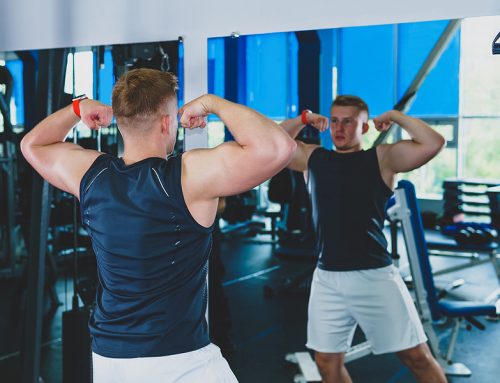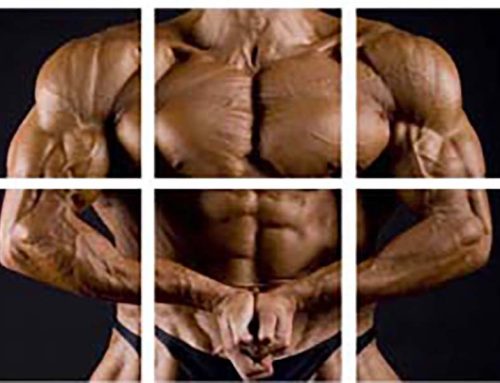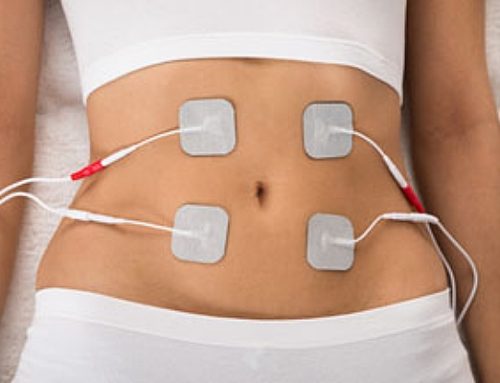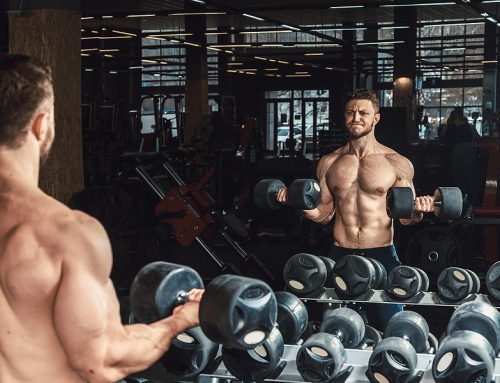A lot of people are horrified of losing muscle. In one sense, they should be, especially as they enter middle age, and head into late life. Have you ever seen old people hobbling around, or worse, needing a cane, walker or wheelchair? Have you seen older folks barely able to stand up and get out of a car, unable to open a heavy door or too weak to lift a heavy box from UPS? I have. You know what that is? Yes, sometimes things happen to our health that are out of our control. But no, it’s not the automatic consequence of aging. We know this because there are elderly men and women who are still athletic and highly functional. What it is is muscle weakness (lack of strength). This is largely a result of losing muscle as the years passed by and nothing proactive was done to stop it. Losing muscle = losing strength = losing function.
Losing muscle mass is not quite so serious when you’re a youngster. The body is more forgiving. Thanks to “muscle memory” you can still gain back the lean mass quickly. But even if you’re a twenty or thirty-something, muscle loss is still a possibility, especially when you’re dieting for fat loss on low calories. And when it happens, it can be frustrating.

Here’s a case study in point. Steve, one of our long time Burn the Fat Inner Circle members (age 34) was doing a cutting (fat loss) phase over the summer. Mid-way through, he messaged me in a panic and said:
“Tom, I’m on a mission to get my body fat down low enough to see my abs. After 6 weeks, I’ve lost 6 pounds, from 174 to 168. I’m okay with the slow weight loss, and in fact I thought that losing slowly would prevent muscle loss, but I’m freaking out because the skin fold calipers say my body fat is only down 1%, leading me to believe almost half the weight I lost is muscle. How do I keep the fat loss going without losing muscle? Or should I stop and go back to a muscle gaining phase?”
I get messages like this every week. I have a pretty standard answer I give, where I share the 2 biggest factors that prevent muscle loss, and there are almost a dozen strategies in total to help maintain lean mass. But first, I usually probe for more clarification, including whether that body fat test is “lying” and indicating that little or no muscle was lost at all.
First, I told Steve to question whether his body fat test was accurate. There’s a large margin for error in caliper measurements, sometimes showing a false negative. If the body fat test was wrong, the lean body mass calculation was wrong too. I suggested that he look in the mirror and ask if his body fat test results matched what he was seeing with his own eyes. I told him not to judge his success based on a skinfold caliper measurement alone unless he’s 100% certain the test was accurate. I pointed out that if he measured a 1% body fat loss but in reality he lost 3%, then his weight loss was almost pure fat with no muscle loss.
I also explained how water weight can throw things off. Water weight can fluctuate daily, masking body composition change. Changes in body hydration can make it appear that you either gained or lost muscle, when it was only a change in fluid levels. This is especially common when you reduce carbs. Some of the weight loss was water loss, not muscle loss.
I also pointed out that it’s important to make a distinction between “dry muscle tissue” and “lean body mass (LBM)” or fat-free mass. If your results show a 3 pound decrease in LBM, that does not mean it’s muscle loss. LBM is not one and the same with muscle. Muscle is simply a large component of the LBM. LBM also includes water, organs, glycogen, digestive system contents and all other fat free tissue.
How do you know if you’re losing muscle mass?
Because of all these factors, you can’t always judge your progress by body fat tests or the scale alone. Don’t let the body fat calipers or scale push you around or dictate your mood and motivational state. Instead, look at other factors that might provide feedback about your true progress.
How do you look in the mirror? Do you look like you’ve lost muscle? If your muscularity looks the same or better, you are probably not losing muscle. How are your strength levels? If you’re dieting in a deficit and maintaining your strength, that’s a good sign that you’re not losing muscle. If your strength is going up, thats a strong sign that you’re not losing muscle.
If your muscles look visibly smaller and if your strength is decreasing, these are signs confirming that a body fat test showing muscle loss was accurate. If the signs suggest you have lost muscle, you may need to make some program adjustments in both nutrition and training. To help you with this task, I’ve created a list of the top 11 strategies to prevent (and even reverse) muscle loss.
Before you scroll through the whole list, it’s important to know that there are 2 primary strategies for preventing muscle loss that are more important than all the others. One is resistance training. The other is an adequate protein intake. If you get these two things right alone, you’re probably 90% of the way there.
11 Strategies to Prevent Muscle Loss
1. Check for adequate protein.*
One of the top 2 strategies for preventing muscle loss is to ensure you are consuming enough protein. According to the most recent scientific evidence, an optimal protein intake for people who are resistance training is .73 g to 1 g per pound of body weight. It surprises a lot of people that research says that as little as .73 g per pound is adequate and you won’t build more muscle beyond that. However, that is assuming a calorie intake at maintenance or above. When your calories are restricted for fat loss, higher protein intakes help protect you from losing muscle during the diet. So while the low end of this optimal protein range is sufficient for most people, if you’re in a deficit and you’re worried about muscle loss, you may want to consider sliding up to the upper end of the range.
2. Consider raising protein above the normal range (very high protein).
Scientists have discovered that the leaner you are, the higher your risk of muscle loss. It’s also well known that the bigger your calorie deficit is (the lower your calories), the higher your risk of muscle loss. When you’re already lean, and trying to get even leaner, and when your calories are low, you should be aiming for at least 1 g per pound. There is also some evidence that you may benefit from raising protein even higher, scaling up protein intake based on your level of leanness and the severity of the calorie deficit. If you’re already lean and trying to get ripped and your calories are very low, consider increasing protein beyond the typical recommendations. Competitive physique athletes typically consume anywhere from 1.1 g to as high as 1.5 g per pound during contest prep (this is VERY high protein).
3. Check for adequate carb intake.
Some people suffer higher losses of LBM when carbs are inadequate, particularly under 100 -150 grams per day for women / men respectively. It’s not that low carb diets are catabolic and eat up muscle per se. Some studies have shown that even people on extreme low carb (keto) diets maintained their LBM as long as they were weight training. The biggest issue is whether your training suffers with very low carb intake. Keep in mind that individual responses may vary. Some people can keep their training intensity up while on low carbs. Others find they lose energy and strength when carbs are low. Use resistance training performance as your guide for how to adjust carbs.
4. Make sure you are weight training consistently.
Possibly the most important factor of all for maintaining LBM while dieting is resistance training. Weight training should be a foregone conclusion regardless of your training goal. The benefits are incredible. However , many people avoid serious weight training, and almost everyone misses workouts from time to time. Everyone should lift as consistently as possible, but if you suspect you are losing muscle, resistance is the single most important thing you can do to stop it, and then reverse it.
5. Check your strength levels during training.
Make sure your weight training program is properly designed to help you get stronger and you are working on increasing your strength. Lean mass seldom drops while strength is going up. The leaner you get and the further you get into your fat loss phase, the harder it is to continue getting stronger, but progressive overload resistance training should always be your goal. If you’re doing only body weight exercise, only light weight training, easy circuit training, or non-progressive types of strength training, it’s time to step up your game and start lifting some heavier and heavier iron.
6. Check your recovery levels from training.
Be certain that (a) you are not overtraining in duration or intensity, (b) you are allowing adequate recovery time in between workouts (appropriate frequency of training), and (c) you are allowing appropriate recovery for your body (some people can thrive on higher volume, higher frequency training, others cannot).
7. Check your sleep.
A recent study published in the Annals of Internal Medicine found that for a given deficit and a given amount of weight loss, sleep curtailment decreased the proportion of weight lost as fat by 55% (at 5.5 hours of sleep versus 8.5 hours of sleep). The research also showed neuro-endocrine adaptation to calorie restriction and increased hunger which could indicate likelihood to eat ones way out of calorie deficit. If you’re getting healthier, leaner, stronger and more muscular, consistently, with under 7 hours of sleep, consider yourself lucky and carry on. If not, then stop blowing off the most restorative and health promoting behavior of all.
8. Check your stress levels.
Stress can have similar effects on neuro-endocrine markers as sleep deprivation, including increased cortisol, increased visceral fat deposition, impaired glucose tolerance, insulin resistance and hyperinsulinemia. If you’re stressed and you know it, escape the source of the stress or develop coping mechanisms fast or your training will be an uphill battle.
9. Check your cardio level.
The idea that normal, moderate amounts of cardio will cause muscle loss is complete nonsense. However, higher volumes of cardio or endurance sport training done currently with resistance training show that cardio can interfere with strength gains, especially in the lower body, and especially if all the cardio you do is high in intensity. For maximum fat loss, it’s beneficial to include cardio as often as every day, so this is a conflict of opposing goals. One solution is to keep up the frequent cardio but keep some of it low to moderate in intensity and don’t overdo the duration (hours and hours of daily cardio are not necessary for fat loss. If you can’t get it done with 45-60 minutes per day of cardio, there is something terribly wrong with your nutrition). Backing off high volume cardio when fat loss is a primary goal is counter-intuitive, but if there are confirmed losses in LBM, and you’ve been stressed and overtrained, sometimes it’s better to use low to moderate amounts of cardio and manipulate your nutrition to get the calorie deficit you need.
10: Check your calories. Avoid aggressive deficits.
There has been controversy over the idea that losing weight slowly is superior for long term success than losing weight quickly. However, whether this is true depends on the context – it may depend on your goal and your current level of body fat. Studies have found that obese people who lose weight quickly, rather than risking relapse, actually find themselves more motivated with quick initial weight loss, and there is not a higher rate of weight regain. However, in people who are already lean, such as athletes or bodybuilders dieting for competition, studies find that a slower rate of weight loss is superior for preserving lean body mass. A study from Norway found that in athletes, losing only .5 kg per week retained muscle while in a deficit better than people who lost 1 kg per week.
11: Check your supplements. Consider taking creatine.
Most supplements are a waste of money. Personally, I take zero supplements. However, creatine has been shown not only to help improve performance during strength and anaerobic training, but also to help prevent muscle loss. It’s the most studied sports supplement in history. It’s safe and it works. Though creatine is not mandatory, when you are looking for ways to decrease risk of muscle loss, it’s something to think about. (Disclosure: I have NO affiliation with the supplement industry and do not recommend or endorse any brands or companies).
I hope this helps.
Train hard and expect success,
-Tom Venuto, Author of, Burn the Fat, Feed the Muscle (BFFM)
Author of, The BFFM Guide To Flexible Meal Planning For Fat Loss
Founder of, Burn the Fat Inner Circle
PS. Setting protein intake properly is one of your most important nutrition program goals. If you’re not sure how to set your daily protein number, then be sure to read our post: The New Rules Of Setting Your Macros

Tom Venuto is a natural bodybuilding and fat loss expert. He is also a recipe creator specializing in fat-burning, muscle-building cooking. Tom is a former competitive bodybuilder and today works as a full-time fitness coach, writer, blogger, and author. In his spare time, he is an avid outdoor enthusiast and backpacker. His book, Burn The Fat, Feed The Muscle is an international bestseller, first as an ebook and now as a hardcover and audiobook. The Body Fat Solution, Tom’s book about emotional eating and long-term weight maintenance, was an Oprah Magazine and Men’s Fitness Magazine pick. Tom is also the founder of Burn The Fat Inner Circle – a fitness support community with over 55,000 members worldwide since 2006. Click here for membership details
Scientific References
Antonio J et al, The effects of consuming a high protein diet (4.4 g/kg/d) on body composition in resistance-trained individuals, Journal of the International Society of Sports Nutrition 11:19, 2014.
Ballor DL, Poehlman ET. Exercise-training enhances fat-free mass preservation during diet-induced weight loss: a meta-analytical finding. Int J Obes Relat Metab Disord. 1994 Jan;18(1):35-40. Department of Human Development Studies, University of Vermont, Burlington 05405-0117.
Devkota S, Layman D, Protein metabolic roles in treatment of obesity, Current Opinion In Clinical Nutrition and Metabolic Care, 13: 403-407, 2010.
Forbes G, body fat content influences the body composition response to nutrition and exercise, Ann N Y Acad Sci, 904: 356-365, 2000.
Garthe et al, Effect of two different weight-loss rates on body composition and strength and power-related performance in elite athletes. Int J Sport Nutr Exerc Metab. 21(2):97-104. 2011
Geliebter A et al, Effects of strength or aerobic training on body composition, resting metabolic rate, and peak oxygen consumption in obese dieting subjects.Am J Clin Nutr. 1997 Sep;66(3):557-63.
Hansen T, Predictors of successful weight loss with relative maintenance of fat-free mass in individuals with overweight and obesity on an 8-week low-energy diet. Br J Nutr. 2019 ;122(4):468-479.
Helms E et al, A Systematic review of dietary protein during caloric restriction in resistance trained lean athletes: A case for higher intakes, International Journal of Sport Nutrition And Exercise Metabolism, 24: 127-138, 2014.
Stiegler P, Cunliffe A.The role of diet and exercise for the maintenance of fat-free mass and resting metabolic rate during weight loss. 1: Sports Med. 36(3):239-62. 2006.






Leave A Comment